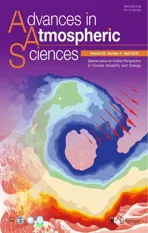Evaluating the Formation Mechanisms of the Equatorial Pacif c SST Warming Pattern in CMIP5 Models
2016-11-24JunYINGPingHUANGandRonghuiHUANG
Jun YING,Ping HUANG,and Ronghui HUANG
1Center for Monsoon System Research,Institute of Atmospheric Physics,Chinese Academy of Sciences,Beijing 100190
2University of Chinese Academy of Sciences,Beijing 100049
3Joint Center for Global Change Studies,Beijing 100875
Evaluating the Formation Mechanisms of the Equatorial Pacif c SST Warming Pattern in CMIP5 Models
Jun YING1,2,Ping HUANG∗1,3,and Ronghui HUANG1
1Center for Monsoon System Research,Institute of Atmospheric Physics,Chinese Academy of Sciences,Beijing 100190
2University of Chinese Academy of Sciences,Beijing 100049
3Joint Center for Global Change Studies,Beijing 100875
Based on the historical and RCP8.5 runs of the multi-model ensemble of 32 models participating in CMIP5,the present study evaluates the formation mechanisms for the patterns of changes in equatorial Pacif c SST under global warming. Two features with complex formation processes,the zonal El Ni˜no-like pattern and the meridional equatorial peak warming(EPW),are investigated.The climatological evaporation is the main contributor to the El Ni˜no-like pattern,while the ocean dynamical thermostat effect plays a comparable negative role.The cloud-shortwave-radiation-SST feedback and the weakened Walker circulation play a small positive role in the El Ni˜no-like pattern.The processes associated with ocean dynamics are conf ned to the equator.The climatological evaporation is also the dominant contributor to the EPW pattern,as suggested in previous studies.However,the effects of some processes are inconsistent with previous studies.For example, changes in the zonal heat advection due to the weakened Walker circulation have a remarkable positive contribution to the EPW pattern,and changes in the shortwave radiation play a negative role in the EPW pattern.
global warming,equatorial Pacif c SST warming pattern,multi-model ensemble,CMIP5
1.Introduction
ThewarmingpatternsofequatorialPacif cSSTduetorising greenhouse gas concentrations is one of the most important problems in projecting regional climate change and has thus been paid considerable attention in the research community for decades(Clement et al.,1996;Collins,2005;Liu et al.,2005;Xie et al.,2010;Ma and Yu,2014).The patterns of equatorial Pacif c SST warming(EPSW)affect various aspects of regional and global climate change.For example, theydominatethe changesinannual-meanprecipitation,with increased(decreased)rainfall over the areas of large(small) SST warming,and play a more important role in the changes in tropical cyclone intensity than the local absolute SST increases(Vecchi and Soden,2007;Knutson et al.,2008;Xie et al.,2010;Huang et al.,2015).Moreover,the uncertainties of EPSW also dominate the uncertainties of the changes in atmospheric circulation over the equatorial Pacif c(Ma et al., 2012;Ma and Xie,2013).
Two well-known features of EPSW patterns have been obtained from the multi-model ensemble(MME)of CMIP3 andCMIP5,andfromindividualmodel simulations(Fig.1a): the zonal El Ni˜no-like warming pattern(simply referred to as the El Ni˜no-like pattern hereafter),with more warming in the eastern than western Pacif c(Ramanathan and Collins,1991; Meehl and Washington,1996;Collins,2005;Vecchi and Soden,2007;Song and Zhang,2014);and the meridional equatorial peak warming(EPW)pattern(Liu et al.,2005;Xie et al.,2010).However,these patterns remain controversial in different scenarios(DiNezio et al.,2009;Zhang and Li, 2014)and different models(Huang and Ying,2015).For instance,a few studies have suggested a La Ni˜na-like warming (Clement et al.,1996;Cane et al.,1997)or a zonal uniform warming(DiNezio et al.,2009)for the zonal structure of the SST warming over the equatorial Pacif c.
Several distinct mechanisms have been proposed to explain the discrepant SST warming patterns.For the zonal structure,the weakened Walker circulation associated with a slower increase in rainfall than in moisture(Held and Soden,2006)can reduce the zonal SST gradient to promote an El Ni˜no-like pattern by reducing the westward surface wind stress and the westward oceanic current as well as the cold upwelling in the eastern Pacif c(Vecchi and Soden,2007). The zonal SST gradient can also be weakened by a greater evaporative cooling in the western Pacif c than in the easternPacif c(Knutson and Manabe,1995)and by the stronger cloudradiationregulationinthewesternPacif c(Ramanathan andCollins,1991).Ontheotherhand,thezonalSST gradient can be enlarged by the increased ocean vertical temperature gradient in the eastern Pacif c with upwelling colder subsurface water,known as the ocean dynamical thermostat effect (Clement et al.,1996;Cane et al.,1997),favoring a La Ni˜nalike warming pattern.Moreover,the zonal warming pattern can be enlarged by the Bjerknes feedback of zonal air-sea coupling(Bjerknes,1969;Song and Zhang,2014).
©Institute of Atmospheric Physics/Chinese Academy of Sciences,and Science Press and Springer-Verlag Berlin Heidelberg 2016
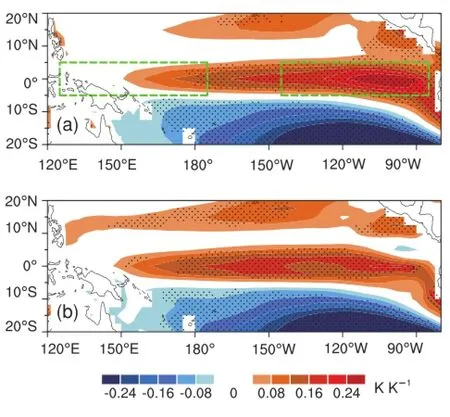
Fig.1.The(a)MME SST warming pattern and(b)mixed layer ocean temperature warming pattern in the equatorial Pacif c. Stippling indicates that more than 80%of models have the same sign.
In terms of the meridional pattern,Seager and Murtugudde(1997)attributed the EPW pattern to the weaker trade wind at the equator than that in the subtropics,and Liu et al.(2005)to the changes in latent heat,shortwave cloud forcing and ocean vertical mixing.Xie et al.(2010)further emphasizedthedominantroleoftheclimatologicalminimum of evaporative cooling at the equator.
All of these formation mechanisms seem theoretically reasonable.However,somemechanismscanbefoundmerely in individual model experiments.For example,the ocean dynamical thermostat as a damping effect to the El Ni˜no-like patternwas foundin the Zebiak-CaneCGCM with a uniform heat f ux forcing situation(Clement et al.,1996).Based on hybrid CGCM experiments,the EPW pattern was attributed to the stronger trade wind speed in the subtropics than at the equator(Seager and Murtugudde,1997),whereas the effect of evaporative cooling was suggested based on the simulations of the GFDL's CGCM(Knutson and Manabe,1995). However,the performances of these mechanisms in a large group of models remain unclear.
In the present study,we analyze the changes in the ocean mixed layer energy budgets in 32 CMIP5 models to evaluate the importance of these mechanisms on the formation of the equatorial Pacif c SST warming pattern.To quantify the importance of these mechanisms,we decompose the ocean mixed layer energy budgets into various terms to represent the respective mechanisms.The paper is organized as follows:Section 2 describes the models,variables and methods. Section 3 presents the results.Conclusions are given in section 4.
2.Models and methods
2.1.Models and variables
Outputs from 32 CMIP5 models are used in the present study.Table 1 lists the names and relevant organizations of the 32 models.The details of the models can be found at http://www-pcmdi.llnl.gov/(Taylor et al.,2012).The historical runs for the period 1981-2000 and the RCP8.5 runs for 2081-2100 are used to represent the current and future climate,respectively.
The variables include the monthly mean SST,total cloud fraction(its standard variable name in CMIP5 is clt),surface latent heat f ux(QE),sensible heat f ux(QH),net longwave radiation(QLW),net shortwave radiation(QSW),surface zonal(uas)and meridional(vas)wind velocity,surface scalar wind speed(sfcWind),ocean temperature(thetao),and ocean 3D mass transport(umo,vmo,and wmo).The net longwave/shortwaveradiation is def ned as the difference between upward and downward longwave/shortwave radiation. The sign of the f ux is def ned such that a positive f ux warms the ocean.Some variables not archived in a few models are marked in Table 1.Moreover,the ocean vertical mass transport not well described in CSIRO Mk3.6.0,BNU-ESM and MIROC5isalsoexcluded(http://cmip-pcmdi.llnl.gov/cmip5/ errata/cmip5errata.html).Ocean 3D currents are obtained from the ocean 3D mass transports.All of the model outputs are interpolated onto a 2.5◦×2.5◦grid.
2.2.Def nition of the EPSW pattern
The change under global warming is f rst def ned as the difference between the 20-year long-term mean of the RCP8.5 run and that of the historical run.Changes in each model are normalized by their respective tropical SST warming averaged between 60◦S to 60◦N,in order to remove the inf uence of tropical mean SST change.Then,the regional mean SST increase is removed to def ne the EPSW pattern. As shown in Fig.1a,the sign agreement test indicates that most of the CMIP5 models(more than 80%of the 32 models)show some universal patterns of EPSW.
2.3.Decompositions of heat budgets
The formation mechanisms of the EPSW patterns can be detected from the surface energy budget changes.For instance,the effect of evaporative cooling can be represented by the latent heat changes(Xie et al.,2010),the effect of cloud-shortwave-radiation-SST feedback by the shortwave radiation changes(Ramanathan and Collins,1991),and the effect of the ocean dynamical thermostat is implied in the ocean heat transport changes(Clement et al.,1996;DiNezioet al.,2009).
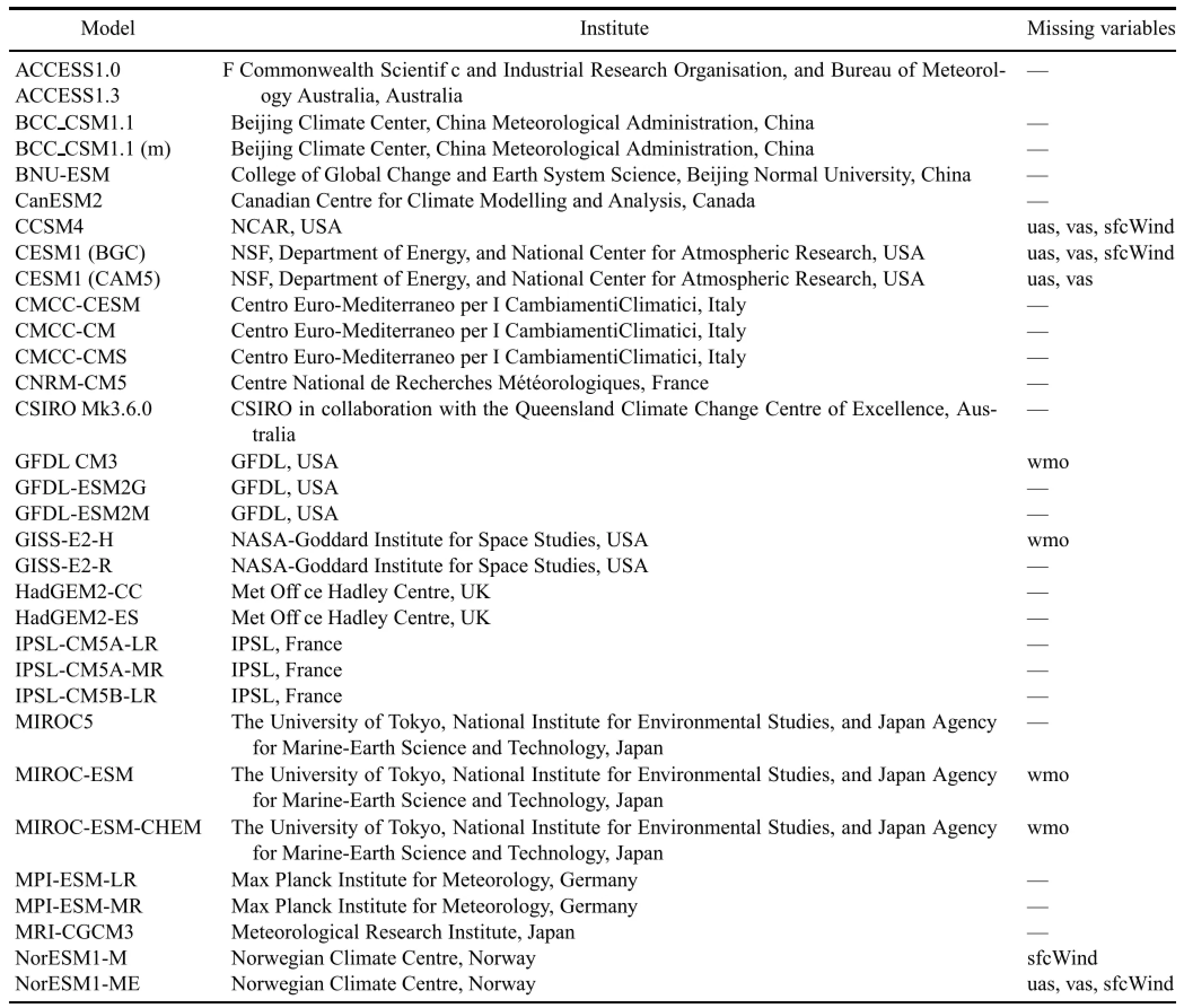
Table 1.List of the 32 CMIP5 models used in the present study.
For the change in long-term mean,the energy budget balance in the ocean mixed layer can be expressed as(Xie et al., 2010)

where∆denotes future change.∆QE,∆QH,∆QLW,∆QSWand∆DOrepresent changes in latent heat f ux,sensible heat f ux, net longwave radiation,net shortwave radiation and ocean dynamical processes,respectively.The DOcan be decomposed as

where∆Qu,∆Qvand∆Qwrepresent changes in the ocean 3D heat transports,and∆R is a residual term representing changes in heat transports due to sub-grid scale processes such as vertical mixing and lateral entrainment(DiNezio et al.,2009).
Because the∆Qu,∆Qvand∆Qwinclude both the effects of changes in ocean currents and changes in ocean temperature gradients associated with different mechanisms,we decompose them into two components:

whereρois sea water density;cpis specif c heat at constant pressure;H is mixed layer depth,chosen as a constant of 30 m;and u,v,w and T are ocean zonal,meridional and ver-tical current,and temperature,respectively.∆Qu1,∆Qv1and∆Qw1representtheeffectofchangesin oceancurrents,which mainly ref ect the role of changes in surface wind stress and in atmospheric general circulation(Vecchi and Soden,2007); and∆Qu2,∆Wv2and∆Qw2represent the effect of changes in ocean temperature gradients.The patterns of mixed layer temperature changes in Fig.1b are close to the EPSW patterns(Fig.1a),with a spatial correlationcoeff cientnear 0.97, indicating that the mixed layer energy budget is reasonable for studying the SST change pattern and that the mixed layer depth(30 m)is properly chosen.
Another important variable involving multiple processes is latent heat f ux(Xie et al.,2010).The surface latent heat f ux in models is calculated using the bulk formulas:

whereρais surface air temperature;L is latent heat of evaporation;CEis the exchange coeff cient;V is surface wind speed;qs(T)is the saturated specif c humidity,following the Clausius-Clapeyron relationship;Tssis SST;and T′is the difference between SST and surface air temperature,known as the stability parameter.RH is the relative humidity,α= L/(RvT2)≈0.06 K−1,and Rvis the ideal gas constant for water vapor.
From Eq.(4),changes in latent heat f ux can be inf uenced by changes in SST,surface wind speed,surface stability and RH,related to different processes(Xie et al.,2010; Huang,2015).Thus,∆QEis decomposed into two parts:∆QE=∆QEO+∆QEA,where∆QEO=αQE∆Tssis the response of SST change(Newtonian cooling)and∆QEAcontains the effects of changes in wind speed,RH and surface stability(Du and Xie,2008;Xie et al.,2010).In∆QEA, the effect due to surface wind speed change can be written as∆QEW=QE∆V/V,which is the key aspect in the windevaporation-SSTfeedback(Xie and Philander,1994)and important to the SST warming pattern formation(Xie et al., 2010).The residual of∆QEA,∆QER=∆QEA−∆QEW,represents both the effect of changes in RH and surface stability.
The∆QEO=αQE∆Tss,includingthe effects of the climatological evaporation QEand the SST change,can be divided into two terms,following Huang(2015):

where the angled brackets denote the tropical Pacif c mean, the prime represents the deviations,the termrepresents the response of the spatially non-uniform SST change, andthe effect of the spatial distribution of the climatological latent heat f ux.
3.Results
Figures2a-cexhibitthechangesinlatentheatf ux(∆QE), net longwave radiation(∆QLW)and net shortwave radiation (∆QSW).Changes in sensible heat f ux(∆QH)are omitted due to relatively small values.SST warming is mainly contributed by increases in net downward longwave radiation, while changes in latent heat and net shortwave radiation suppress surface warming.The regional deviations of these surface energy budgets are shown in Figs.2d-f.Changes in latent heat f ux and net shortwave radiation exhibit pronounced spatial patterns(Figs.2d and f),indicating more important inf uences on the EPSW pattern;whereas,the increases in net longwave radiation(Fig.2e)are mainly spatially uniform,contributed by the near uniform increases in greenhouse gases.
For the ocean dynamics(Fig.3),the 3D heat transports are mainly located in the equatorialPacif c,except the meridional heat transport,which cools the NH and warms the SH offtheequator.Thehorizontalheatadvection(Figs.3aandb) warms the surface of the equator,while the vertical heat advection(Fig.3c)cools SST in the eastern Pacif c.In addition, the residual term mainly warms the equatorial eastern Pacif c and cools the off-equatorialf anks of the eastern Pacif c(Fig. 3d).
3.1.Zonal El Nin˜o-like pattern
In the MME,the SST warming in the eastern Pacif c is larger than that in the western Pacif c,exhibiting an El Nin˜olike pattern.The difference between the regional mean of (5◦S-5◦N,145◦-85◦W)and(5◦S-5◦N,125◦E-175◦W),denoted by the dashed green boxes in Fig.1a,is around 0.12◦C per 1◦C of global warming.
Four mechanisms are suggested to inf uence the zonal pattern formation.The total effect of evaporative cooling, represented by the changes in latent heat f ux,causes warmer SST in the eastern than the western Pacif c,favoring an El Nin˜o-likepattern(Fig.2d).Figures4aandbshowtheNewtoniancoolingeffect(∆QEO)andthe atmosphericforcingeffect (∆QEA).The∆EEOnear the equator is similar to the EPSW pattern(Fig.4a),indicatingafavorablefactorforthe ElNin˜olike pattern.On the contrary,the atmospheric adjustment effect(Fig.4b)appears to damp the El Nin˜o-like warming.In∆EEO,the effect of the spatial distribution of climatological latent heat f ux(∆EEO2,Fig.4d)is the dominant contributor to the total effectof evaporativecooling,favoringan El Nin˜olike pattern(Knutson and Manabe,1995),while the effect of non-uniform SST change(∆QEO1,Fig.4c)plays a damping role.
The cloud-shortwave-radiation-SST feedback is suggested to be another factor favoring the El Nin˜o-like pattern, which can be represented by the changes in shortwave radiation.As shown in Figs.2c and f,there is more decreased net shortwave radiation over the western Pacif c than the western Pacif c,favoring an El Nin˜o-like pattern.To illustrate the role of cloud-shortwave-radiation-SST feedback,a cloudshortwave-radiation-SST feedback index(CSFI)is def ned by regressing monthly net shortwave radiation anomalies to SST anomalies(Sun et al.,2003;Sun et al.,2006),to quantify the strength of shortwave feedbacks in the climate system.Figure 5a shows the spatial distribution of the CSFI in the historical run.The CSFI is negativein most parts near the equator,suggesting a negative convective cloud-shortwaveradiation-SSTfeedback,andpositiveovertheeasternPacif c,indicating a positive stratus cloud-shortwave-radiation-SST feedback(Ramanathan and Collins,1991;Song and Zhang, 2014).The negative(positive)cloud-SST feedback will suppress(enhance)the local SST warming.This process can be demonstrated by the changes in cloud amount(Fig.5b). Thus,the cloud-shortwave-radiation-SSTfeedback weakens the zonalgradientofSST,contributingtoan El Ni˜no-likepattern.
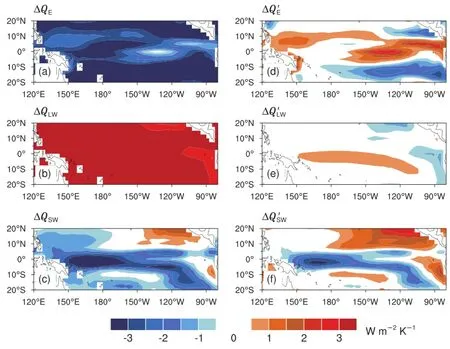
Fig.2.Changes in(a)latent heat f ux(∆QE),(b)net longwave radiation(∆QLW),and(c)net shortwave radiation (∆QSW).(d-f)As in(a-c)but with the respective tropical Pacif c mean removed.
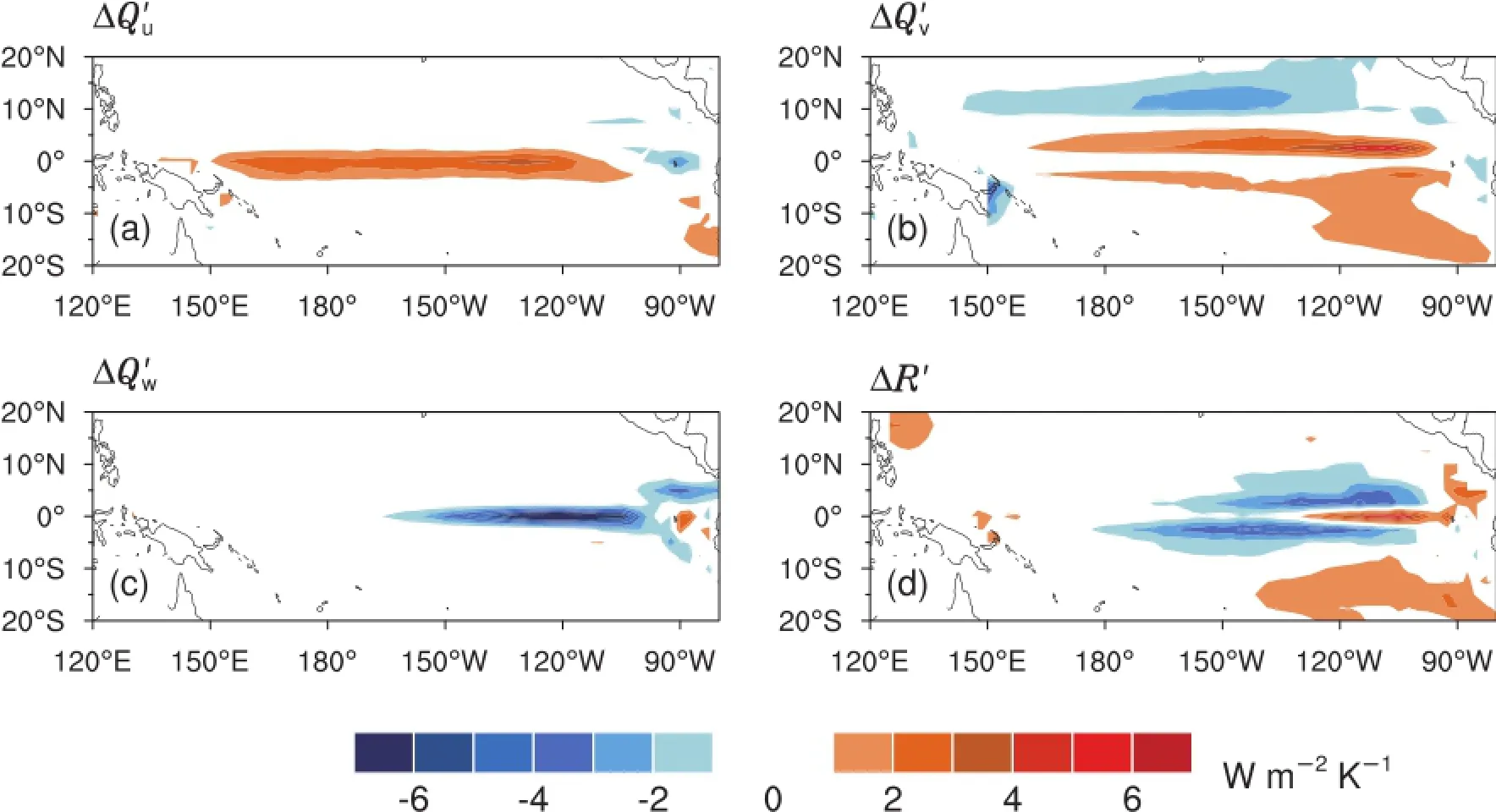
Fig.3.Regional changes in the(a)zonal,(b)meridional and(c)vertical heat transport,and(d)the residual term in Eq.(2).
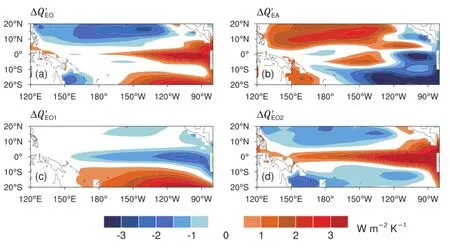
Fig.4.Components of the regional changes in latent heat f ux:(a)∆QEO,(b)∆QEA,(c)∆QEO1and∆QEO2

Fig.5.(a)Cloud-shortwave-radiation-SST feedback index in the historical run.(b)Changes in total cloud fraction.
The changes in ocean heat transports associated with the oceancurrentchanges(Figs.6a-c)indirectlyref ectthe effect of the changes in atmospheric general circulation connected by the surface wind stress changes.The effects of changes in ocean zonal and vertical currents both warm the SST along the equator(Figs.6a,c),which is associated with the weakened Walker circulation(Vecchi and Soden,2007).However, the zonal current changesdo not contributemuchto the zonal gradientofSSTchanges(Fig.6a)becauseofthenearuniform zonalcurrentchanges(Fig.7a).Meanwhile,thedownwelling changes in the eastern Pacif c(Fig.7b)—weakening the cold upwelling and warming the SST—mainly represent the effect of weakened Walker circulation on the zonal gradient of SST changes(Fig.6c and∆Qw1).The effect of changes in meridionalcurrentalsowarmstheSST intheeasternPacif caround 5◦N(Fig.6b)with a relatively weak magnitude,which could be attributed to the weak weakening of the meridional overturning circulation(Vecchi and Soden,2007;Ma and Xie, 2013).
Theoceandynamicalthermostateffectcanberepresented by changes in the ocean heat transports due to changes in ocean vertical temperature gradients(Figs.6f)(Cane et al., 1997;Seager and Murtugudde,1997;An and Im,2014).Under global warming,the ocean vertical temperature gradients will increase(Fig.7b),with less solar radiation absorbed in the subsurface than at the surface.Thus,the background upwelling pulls up cooler subsurface water to cool the surface in the eastern Pacif c,damping the El Ni˜no-like pattern(Fig. 6f).
The energy budget analyses basically verify that the previous suggested mechanisms are pronounced in the MME of the 32 CMIP5 models.However,they also exhibit great discrepanciesin spatialstructureandstrength(Figs.2f,4c andd, and 6).The effects of weakened Walker circulation(Fig.6c) and ocean dynamical thermostat(Fig.6f)are conf ned near the equator(2.5◦S-2.5◦N),with great horizontal gradients, because of the narrow upwelling and stratif cation region in the eastern Pacif c.Whereas,the effects of climatological evaporationand cloud radiationfeedbackextendto 5◦S-5◦N, close to the structure of the SST change pattern.
The effect of climatological evaporation,cloud radiation feedback,the weakened Walker circulation,and the ocean dynamical thermostat can be represented by thezonaldifferences betweentheeastern(5◦S-5◦N, 145◦-85◦W)and western(5◦S-5◦N,125◦E-175◦W)Pacif c of∆QEO2,∆QSW,∆Qw1and∆Qw2,respectively. The climatological evaporation contributes the most to the El Ni˜no-like pattern with the east-west differenceexceeding 2 W m−2(around 2.03 W m−2),while the ocean dynamical thermostat contributes a comparable damping to the El Ni˜no-like pattern formation(−1.96 W m−2).The cloud-shortwave radiation-SST feedback(0.92 W m−2)and the weakened Walker circulation(0.59 W m−2)play a positive but relatively small role.

Fig.6.Regional changes in the ocean heat transports induced by changes in(a)zonal current(b)meridional current(c)vertical current(d)zonal gradients of temperature(e)meridional gradients of temperatureand(f)vertical gradients of temperature

Fig.7.(a)Changes in horizontal currents averaged in the mixed layer(vectors less than 0.02 m s−1are omitted).(b)Vertical gradients of changes in ocean temperature(color shading)and the zonal overturning current(vectors;m s−1)at the equator (averaged between 2.5◦S and 2.5◦N).Changes in vertical velocity are multiplied by 100 for display,and vectors less than 0.05 are omitted.
3.2.Equatorial peak warming pattern
The meridional EPSW exhibits a peak warming at the equator(Fig.8a).Three terms of the zonal-mean heat budgets peak at the equator,favoring the EPW pattern(Fig.8a):representingtheeffectofclimatologicalevaporation;representing the effect of changes in ocean zonal heat transport;andrepresenting the effect of changes in the ocean residual term.On the other hand,the changes in theshortwaveradiationRHandstabilitythe meridional heat transportand the vertical heat transportdamp the EPW pattern(Fig.8b).
Among the mechanisms,the latent heat changes due to the effect of the climatological evaporative cooling is the greatest positive contribution to the EPW pattern(Fig.8a), which was f rst mentioned by Liu et al.(2005)and emphasized by Xie et al.(2010).Another important positive factor in the present analysis,which has not been emphasized,isthe effect of changes in the ocean zonal heat transport due to the weakened Walker circulation(yellow curve in Fig.8a), as demonstrated in Figs.6a and 7a.This result is inconsistent with that in Liu et al.(2005),suggesting the changes in oceaniccirculationarenotimportant.Theresidualterm(∆R′) involving sub-grid scale processes,such as the ocean vertical mixing,also has a positive contribution to the EPW pattern,although its meridional range is relatively small.Meanwhile,these favorable mechanisms are balanced mainly by the effects of changes in the ocean vertical heat transports due to enhanced oceanic vertical temperature gradients and the latent heat changes due to changes in the atmosphericRH and stability(Fig.8b).It should be noted that the effects of changes in shortwave radiation(Liu et al.,2005)and surface wind speed(Seager and Murtugudde,1997),believed to be positive in forming the EPW pattern,do not contribute to the EPW pattern positively.The former damps the EPW pattern, while the latter mainly affects the off-equatorial patterns.
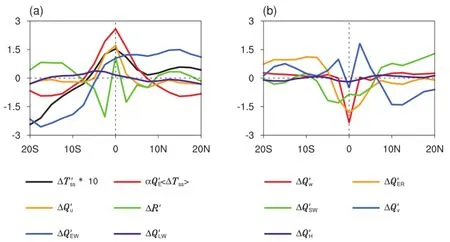
Fig.8.(a)Zonal mean of(multiplied by 10;units:K)and the terms with positive contribution to the EPW pattern(units:W m−2K−1).(b)The terms with negative contribution to the EPW pattern(units:W m−2K−1).
4.Conclusions
This paper analyzes the changes in the mixed-layer energy budget using 32 CMIP5 models,to investigate the formation mechanisms of the annual-mean equatorial Pacif c SST warming patterns.Discussed are two patterns that are pronounced but whose mechanisms are unclear:the zonal El Ni˜no-like pattern and the meridional equatorial peak pattern.
For the El Ni˜no-like pattern,we examined the effects of climatological evaporation,the cloud-shortwave-radiation-SST feedback,the weakening of the Walker circulation,and the ocean dynamical thermostat.The quantitative energy budget analyses,based on the MME of the CMIP5 models, revealed that the effect of climatological evaporation plays a major role,while the cloud-shortwave-radiation-SST feedback and the weakened Walker circulation play relatively small roles.On the contrary,the effect of the ocean dynamical thermostat plays a major negative role,damping the El Ni˜no-like pattern formation,with comparable magnitude to the effect of climatological evaporation.The effects of climatological evaporationand the cloud-radiationfeedback on the equatorextendmuchwider meridionallythan those of the effects associated with ocean dynamics.
For the meridional EPW pattern,the dominant role of the climatological latent heat f ux is also apparent in the MME of the 32 CMIP5 models,as in Xie et al.(2010).Nevertheless,the performances of some mechanisms evaluated in the present study are different from those in some previous studies.The changes in the zonal heat transport due to the weakened Walker circulation make a considerable positive contribution to the EPW pattern,which is inconsistent with the result in Liu et al.(2005).Moreover,the effect of changes in shortwave radiation damps the EPW pattern,which is inconsistent with the positive role proposed by Liu et al.(2005), while the effect of surface wind speed mainly inf uences the off-equatorial patterns,which is also inconsistent with the positive role proposed in Seager and Murtugudde(1997).
The present study is based on the MME of 32 CMIP5 models'outputs.The inter-model spreads in the EPSW are quite large in current CMIP models(DiNezio et al.,2009; Huang and Ying,2015),with great impacts on the uncertainties in projecting regional climate changes(Huang et al., 2013;Ma and Xie,2013).The present energy budget analysis provides a useful method to study the importance of the mechanisms to the inter-model uncertainty in the EPSW, which is worthy of study in the future.
Acknowledgements.The work was supported by the National Basic Research Program of China(Grant Nos.2014CB953903 and 2012CB955604),and the National Natural Science Foundation of China(Grant Nos.41575088 and 41461164005).We acknowledge the World Climate Research Programme's Working Group on Coupled Modeling,which is responsible for CMIP5,and the climatemodeling groups(listed in Table 1)for producing and making available their model output.We also thank the two anonymous reviewers for their constructive suggestions.
REFERENCES
An,S.-I.,and S.-H.Im,2014:Blunt ocean dynamical thermostat in response of tropical eastern Pacif cSST to global warming. Theor.Appl.Climatol.,118,173-183.
Bjerknes,J.,1969:Atmospheric teleconnections from the equatorial Pacif c.Mon.Wea.Rev.,97,163-172.
Cane,M.A.,and Coauthors,1997:Twentieth-century Sea surface temperature trends.Science,275,957-960.
Clement,A.C.,R.Seager,M.A.Cane,and S.E.Zebiak,1996: An ocean dynamical thermostat.J.Climate,9,2190-2196.
Collins,M.,2005:El Ni˜no-or La Ni˜na-like climate change?Climate Dyn.,24,89-104.
DiNezio,P.N.,A.C.Clement,G.A.Vecchi,B.J.Soden,B.P. Kirtman,and S.-K.Lee,2009:Climate response of the equatorial Pacif c to global warming.J.Climate,22,4873-4892.
Du,Y.,and S.-P.Xie,2008:Role of atmospheric adjustments in the tropical Indian ocean warming during the 20th century in climate models.Geophys.Res.Lett.,35,L08712.
Held,I.M.,and B.J.Soden,2006:Robust responses of the hydrological cycle to global warming.J.Climate,19,5686-5699.
Huang,P.,2015:Seasonal changes in tropical SST and the surface energy budget under global warming projected by CMIP5 models.J.Climate,28,6503-6515.
Huang,P.,and J.Ying,2015:A multimodel ensemble pattern regression method to correct the tropical Pacif c SST change patterns under global warming.J.Climate,28,4706-4723.
Huang,P.,S.-P.Xie,K.M.Hu,G.Huang,and R.H.Huang,2013: Patterns of the seasonal response of tropical rainfall to global warming.Nature Geoscience,6,357-361.
Huang,P.,I.-I.Lin,C.Chou,and R.H.Huang,2015:Change in ocean subsurface environment tosuppress tropical cyclone intensif cation under global warming.Nature Communications, 6,7188.
Knutson,T.R.,and S.Manabe,1995:Time-mean response over the tropical Pacif c to increased CO2in a coupled oceanatmosphere model.J.Climate,8,2181-2199.
Knutson,T.R.,J.J.Sirutis,S.T.Garner,G.A.Vecchi,and I.M. Held,2008:Simulated reduction in Atlantic hurricane frequency under twenty-f rst-century warming conditions.Nature Geoscience,1,359-364.
Liu,Z.Y.,S.Vavrus,F.He,N.Wen,and Y.F.Zhong,2005:Rethinking tropical ocean response to global warming:The enhanced equatorial warming.J.Climate,18,4684-4700.
Ma,J.,S.-P.Xie,and Y.Kosaka,2012:Mechanisms for tropical tropospheric circulation change in response to global warming.J.Climate,25,2979-2994.
Ma,J.,and S.-P.Xie,2013:Regional patterns of Sea surface temperature change:A source of uncertainty in future projections of precipitation and atmospheric circulation.J.Climate,26, 2482-2501.
Ma,J.,and J.-Y.Yu,2014:Linking centennial surface warming patterns in the equatorial Pacif c to the relative strengths of the Walker and Hadley circulations.J.Atmos.Sci.,71,3454-3464.
Meehl,G.A.,and W.M.Washington,1996:El Ni˜no-like climate change in a model with increased atmospheric CO2concentrations.Nature,382,56-60.
Ramanathan,V.,and W.Collins,1991:Thermodynamic regulation of ocean warmingby cirruscloudsdeduced fromobservations of the 1987 El Ni˜no.Nature,351,27-32.
Seager,R.,and R.Murtugudde,1997:Ocean dynamics,thermocline adjustment,and regulation of tropical SST.J.Climate, 10,521-534.
Song,X.L,and G.J.Zhang,2014:Role of climate feedback in El Ni˜no-like SST response to global warming.J.Climate,27, 7301-7318.
Sun,D.-Z.,J.Fasullo,T.Zhang,and A.Roubicek,2003:On the radiative and dynamical feedbacks over the equatorial Pacif c cold tongue.J.Climate,16,2425-2432.
Sun,D.Z.,and Coauthors,2006:Radiative and dynamical feedbacks over the equatorial cold tongue:Results from nine atmospheric GCMs.J.Climate,19,4059-4074.
Taylor,K.E.,R.J.Stouffer,and G.A.Meehl,2012:An overview of CMIP5 and the experiment design.Bull.Amer.Meteor. Soc.,93,485-498.
Vecchi,G.A.,and B.J.Soden,2007:Global warming and the weakening of the tropical circulation.J.Climate,20,4316-4340.
Xie,S.-P.,and S.G.H.Philander,1994:A coupled oceanatmosphere model of relevance to the ITCZ in the eastern Pacif c.Tellus A,46,340-350.
Xie,S.-P.,C.Deser,G.A.Vecchi,J.Ma,H.Y.Teng,and A.T. Wittenberg,2010:Global warming pattern formation:Sea surface temperature and rainfall.J.Climate,23,966-986.
Zhang,L.,and T.Li,2014:A simple analytical model for understanding the formation of Sea surface temperature patterns under global warming.J.Climate,27,8413-8421.
Ying,J.,P.Huang,and R.H.Huang,2016:Evaluating the formation mechanisms of the equatorial Pacif c SST warming pattern in CMIP5 models.Adv.Atmos.Sci.,33(4),433-441,
10.1007/s00376-015-5184-6.
17 august 2015;revised 4 October 2015;accepted 27 October 2015)
∗Ping HUANG
Email:huangping@mail.iap.ac.cn
杂志排行
Advances in Atmospheric Sciences的其它文章
- Indo-Western Pacific Ocean Capacitor and Coherent Climate Anomalies in Post-ENSO Summer:A Review
- Role of Horizontal Density Advection in Seasonal Deepening of the Mixed Layer in the Subtropical Southeast Pacific
- Changes in Mixed Layer Depth and Spring Bloom in the Kuroshio Extension under Global Warming
- Historical Change and Future Scenarios of Sea Level Rise in Macau and Adjacent Waters
- The Positive Indian Ocean Dipole-like Response in the Tropical Indian Ocean to Global Warming
- The Southwest Indian Ocean Thermocline Dome in CMIP5 Models: Historical Simulation and Future Projection
